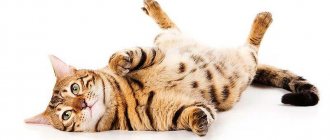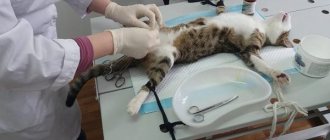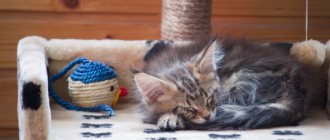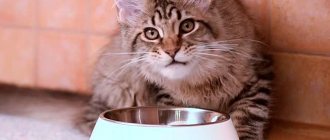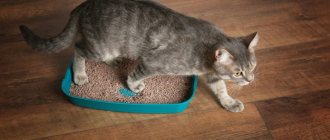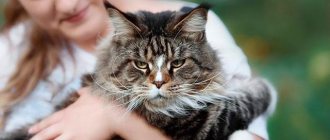Castration is an operation in which the gonads are removed from cats. Although it is not a mandatory procedure, breeders and veterinarians recommend it for all kittens that will not take part in breeding work.
For those who are planning to get a Maine Coon, it is important to know at what age it is better to have a kitten castrated and for which animals it is contraindicated.
What animals are the surgery indicated for?
In European countries and America, castration is treated as a natural process. In Russia there are still many opponents of this procedure. However, those who professionally breed Maine Coons are confident that castration of pets is beneficial. Especially when it comes to animals that cannot be used for procreation.
Neutered Maine Coons live longer and become calmer and more docile. In addition, the quality characteristics of the coat of such pets improve, and the body reaches impressive sizes due to a more active increase in muscle mass. And this is natural, since domestic cats who cannot fully satisfy their sexual instincts suffer. Castration helps relieve your pet from constant stress.
Of course, the cat owner independently decides whether to subject the animal to surgery. However, castration of a pet will relieve many problems:
- marks in the apartment;
- meticulous screams during heat;
- unwanted pregnancy of a pet;
- aggression and nervous behavior, which often occurs against the background of sexual hunting.
In addition, castration is carried out for medical reasons. Procedure required:
- if the cat has a tumor on the ovary or uterus;
- in the presence of a breast tumor;
- with purulent inflammation of the uterus;
- after pregnancy, which was very difficult;
- after poorly performed earlier sterilization.
Why castrate
In Europe and America, castration is perceived as a natural and necessary process. In Russia there are many opponents of the procedure, who believe that it is unnatural and brings pain to the pet. At the same time, people forget that the cat is domesticated and its reproductive cycles have gone astray. And if the owner cannot ensure the satisfaction of instincts, then he dooms the pet to constant stress.
Breeders agree that not castrating a cat means abusing him. This affects the animal’s psyche, causes urological diseases, and makes life shorter.
Benefits of castration for Maine Coons:
- Lifespan increases by almost 1.5 times due to the absence of stress due to hormones.
- The risk of developing urolithiasis (urolithiasis) in cats is reduced by 30%. Neutered cats suffer less from fibroids, cysts, and cancer.
- With properly organized nutrition (neuters need 30% less calories), their size increases due to muscle building, not fat deposits. And most owners want to raise a giant Maine Coon.
- The character of a castrated animal is more friendly. Even Maine cats, distinguished by their independence, become affectionate, human-oriented, and try to spend more time with him.
At what age should a Maine Coon be neutered?
When determining the appropriate age for surgery, the characteristics of the breed of a particular animal are taken into account. Small animals mature earlier, large ones a little later. Veterinarians recommend castrating cats and female cats before the first signs of sexual heat appear.
Optimal age of castration
Puberty in Maine Coon cats occurs between 7 and 9 months. Veterinarians advise castration at this age. It is advisable to have time to carry out the procedure before the cat begins to mark.
As for cats, their owners should not wait until the first hunt begins. “Idle” estrus can lead to inflammation of the uterus. For this reason, it is also advisable to sterilize females before puberty - at 7-8 months.
Important! If your Maine Coon cat goes into heat before castration, you need to inform your veterinarian and postpone surgery for 2 weeks. Otherwise, complications may arise.
Surgery at an early age: pros and cons
You can castrate a Maine Coon at an earlier age. This is practiced by breeders before selling a kitten that cannot be used for breeding. To exclude the possibility of procreation, the gonads are removed.
The operation is performed shortly before the pet is handed over to new owners - at the age of 2-4 months. The main condition for its implementation is the absence of health problems.
Attention! Early castration of a Maine Coon is contraindicated only in one case - with cryptorchidism. In such a situation, intervention is postponed until the testicles descend into the scrotum, or abdominal surgery is performed.
The advantages of early castration are obvious:
- Preparation for the operation, as well as post-operative care, is carried out by the breeder.
- The future owner of a Maine Coon does not risk anything.
- The new owner will not have to pay for the procedure.
Is it possible to castrate mature animals?
It is better to neuter your Maine Coon at a young age. Young individuals tolerate the effects of anesthesia more easily, and the healing process occurs faster. Pets over 7 years of age have an increased risk of complications.
There are several reasons for castrating Maine Coons in adulthood:
- the need to remove the animal from breeding;
- the pet did not cope well with the next pregnancy and childbirth;
- development of hormone-dependent tumors.
Maine Coon cats that have been used for breeding are sterilized at 5-6 years of age. This reduces the risk of inflammatory and tumor complications. Breeding cats are neutered at about the same age. However, in most cases this does not affect the behavior of the male. Even after removal of the gonads, a cat that previously participated in breeding will retain its previous habits and instincts. Many mature animals continue to mark after castration.
Important! If there is a need for surgery on a Maine Coon over the age of 7 years, you must first thoroughly examine him. It is important to make sure that your pet does not have problems with the heart and other vital organs. Otherwise, the animal may not tolerate surgery well.
Age at first mating
Maine Coons reach sexual maturity at 7–8 months. During this period, cats have their first heat, and the cats begin to mark their territory. From this moment on, the animals are ready to mate and are able to bear offspring. However, there is no need to rush into starting breeding work: you need to allow the Maine Coon’s body to mature and get stronger.
At one and a half years old, the Maine Coon cat is ready for breeding work and is at its hormonal peak. It is during this favorable period that the first mating should be carried out: this way the owner will receive a strong and experienced sire.
By the age of one and a half years, Maine Coon females reach full maturity, by which time they are in their third heat. The cat’s body is stronger and ready for pregnancy. At this age, the peak of sexual heat occurs, and the first mating should take place without complications.
Contraindications and possible complications
In some cases, the animal is not allowed to undergo surgery. Contraindications to castration are as follows:
- there are signs of an infectious disease;
- period of exacerbation of chronic ailments;
- Maine Coon is infected with parasites;
- heart, kidney or liver problems;
- epilepsy;
- severe exhaustion;
- respiratory diseases, including asthma;
- estrus;
- pregnancy and lactation;
- postpartum period (up to 1 month);
- lack of vaccinations.
Preparing for castration
When answering the question at what age can a Maine Coon be neutered, it should be noted that you should not delay the procedure. The older the individual, the higher the risk of complications associated with anesthesia. Before sending an adult pet to the operating table for castration, it is necessary to conduct a number of medical studies.
Prohibitions on spaying or neutering Maine Coons include:
- Acute diseases. Their presence weakens the body, increasing possible risks.
- Lack of vaccinations against infectious diseases. During the rehabilitation period, the pet may “catch” an infection due to weakened immunity, and for the same reason the course of the disease will be more severe. It is also necessary to vaccinate a cat before castration if it has been vaccinated for a long time.
- The period of estrus in Maine Coon females. For physiological reasons, the uterus swells at this time, and during surgical intervention during sterilization, large blood losses are possible.
- Full stomach. It is not recommended to feed the animal 12 hours before a planned castration operation. Drinking is allowed, but in small quantities.
Experts also advise performing an ultrasound of the heart to identify possible pathologies that may appear during castration.
Preparation and performance of the operation
Before spaying or neutering a Maine Coon cat, you need to rule out possible health problems. The pet must be examined by a veterinarian. If necessary, laboratory blood tests, ultrasound of the heart and abdominal organs, and a cardiogram will be performed.
The pet must not be fed for 12 hours before castration. Stop drinking 2 hours before the procedure.
Castration of a Maine Coon cat is a simple procedure. It lasts several minutes and is carried out like this:
- The animal is placed on the table and anesthesia is administered.
- Then the work area is shaved and treated with an antiseptic.
- An incision about 1 cm long is made on the scrotum and the testes are removed.
- The spermatic cords are ligated and stitched with threads that will soon dissolve.
- The edges of the wound are tightened with special glue and treated with an antibacterial composition.
- When performing abdominal surgery, sutures are applied after the testes are removed.
- The cat is under the supervision of a veterinarian until he comes to his senses.
In cases where anesthesia is contraindicated for a Maine Coon, chemical castration is recommended. This is a procedure in which an implant containing medication is injected under the animal's skin. The active substance interferes with the synthesis of sex hormones and suppresses reproductive function.
How is the operation performed?
Castration is carried out by a qualified veterinarian in a trained and well-equipped operating room. It is undesirable to operate at home, since the risk of wound infection increases in conditions of insufficient sterility of the room.
At the first stage, the veterinarian shaves (plucks) the hair on the scrotum, and then treats the surgical field with antiseptics. There are two ways to operate: closed and open.
In the first case, the doctor acts according to the following scheme:
- Cutting the skin with a scalpel;
- Extraction of the testis and appendage from the surgical wound;
- Ligation of the cord, covered with the common vaginal membrane, with two ligatures of thin catgut;
- Cutting off the testis along with part of the spermatic cord 1 cm above the lower ligature;
- Checking the reliability of ligatures;
- Resection of the second testis through a second incision in the scrotum;
- Introduction of antiseptic ointment.
Open operation:
- Dissection of the scrotal tissue with a scalpel simultaneously with the vaginal membrane;
- Extraction of the testis and appendage from the surgical wound;
- Separation of the spermatic cord and sperm duct;
- Formation of a biological node (parts of the testis are connected to each other several times (4-6);
- Excision of the second testis;
- Antiseptic treatment.
No stitches are applied, the wound heals by secondary intention. In most cases, the animal’s rehabilitation lasts 1-2 days, and complications arise in rare cases.
Postoperative care for animals
After surgery, your Maine Coon needs good care. When recovering from anesthesia, the cat feels nausea and dizziness, coordination of movements is impaired, and the animal does not orient itself in space.
Upon returning home, it is better to place the Maine Coon on a waterproof diaper on the floor - he may fall off the sofa. It is advisable to be close to your pet and make sure that he does not get up. After castration, it is better for a cat to wear a collar around his neck, which will prevent the animal from licking the wound. Cats have a blanket placed over their bellies. The owner must monitor the condition of the stitches and treat them daily with a product prescribed by the veterinarian.
The Maine Coon is not fed for 4 hours after castration. Water can be offered after 1.5 hours. Some animals may vomit, others may urinate spontaneously. This is normal, there is no need to panic. For several hours after castration, the animal feels severe chills, so it is better to cover it with a blanket or blanket.
Cats recover quickly after castration. The incision site on the scrotum heals within a couple of days. Rehabilitation of cats takes longer – up to 2 weeks. The sutures are removed on the 10th day. But even after this, it is advisable not to allow your pet to run and frolic for at least 3-5 days.
Further care
The first days after surgery, you need to carefully monitor your pet.
In order to notice possible complications in time and, if they occur, immediately contact the clinic.
Postoperative care for the Maine Coon itself includes monitoring the condition of the surgical suture and treating it with an antiseptic recommended by the doctor.
You cannot feed a cat for 5 - 8 hours, but he can drink water.
In order to avoid infection of the surgical wound, it is necessary for the Maine Coon to go into an empty litter box for the first 5 days after surgery.
As a last resort, you can leave only the thinnest layer of filler, but only when the pet categorically refuses to use an empty tray. To prevent the cat from licking the stitches, a postoperative blanket is put on it. You can also put a special bell-shaped collar on the animal, which prevents the Maine Coon from licking itself. At first, the pet can be fed with regular food, but later it will be necessary to switch it to special dietary food for neutered cats and female cats.
Features of cat sterilization
The operation to remove the ovaries and uterus is called castration. In contrast, spaying a cat involves tubal ligation. The second method only prevents pregnancy. In this case, sex hormones continue to be produced. This operation does not affect the cat’s behavior - its natural instincts are preserved.
In both cases, the procedure is performed under general anesthesia. There are two ways to perform castration - laparoscopy and abdominal surgery. In the first case, several holes are made on the Maine Coon's belly, through which the veterinarian removes or ligates the organs. The second option is more traumatic, as it involves a deep incision, which is made with a scalpel. After surgical manipulation of the reproductive organs, the doctor applies stitches.
Alternative method
Not all sterilization options that exist today were presented above. No one has canceled the proven method of ligating the fallopian tubes.
The main advantage of this procedure is the complete exclusion of the appearance of future offspring. On the other hand, the animal will face the following disadvantages:
- persistence of hormonal surges;
- periodic manifestations of nervousness and even aggression;
- there is a risk of tumor formation on organs related to the reproductive system.
Based on the information presented above, experts do not recommend resorting to this method of sterilizing an animal. Cat owners themselves do not want their pet to suffer.
How the animal’s character and habits change after the procedure
The temperament of neutered Maine Coons improves. Pets become calmer and more affectionate, and are loyal to other pets that live in the apartment. Cats stop estrus and the heart-rending screams that accompany them. Young Maine Coons remain interested in games. Mature individuals become lazy and rest most of the time.
Since physical activity in neutered Maine Coons is slightly reduced, the risk of obesity increases. In this regard, veterinarians recommend switching cats to dietary food with a high protein content.
Attention! After castration, it is necessary to carefully monitor the condition of the Maine Coon's heart and kidneys. It is recommended to undergo examination at a veterinary clinic at least 1-2 times a year.
Why is castration necessary?
When contacting specialists, castration or sterilization of Maine Coons is painless, and cats recover quite quickly after the operation.
© shutterstock
Those who are wondering whether to castrate a Maine Coon should familiarize themselves with the goals of the procedure:
- Eliminate odor. Several times a year, animals experience an irresistible attraction to the opposite sex. In Maine Coon males, this results in them marking corners to attract females. Unpleasant odors appear in the apartment, and the owners a priori cannot like this.
- Taking care of your physical health. Maine Coon cats, who are in a period of increased sexual activity, behave aggressively, due to the desire to protect their territory from the presence of other males. This is accompanied by constant fights that end in injury to the pet. It is necessary to sterilize a Maine Coon cat for the same reason, since in animals with no sexual desire the risk of developing diseases of the reproductive organs is minimized. And the life expectancy of a sterilized Maine Coon increases several times, which is due to the absence of hormonal surges and associated stress.
- Concern for morale. A cat or cat living in an apartment is in real greenhouse conditions. When the natural instinct of reproduction is regularly dissatisfied, they begin to mark territory, peel off wallpaper and fight. Castration or sterilization is necessary to avoid putting the animal in this state. At the same time, the operation will save the nerves of both the owners and the pets themselves.
- Relief of reproductive function. Attempts to make life easier for a pet by mating with random individuals will lead to an increase in the number of yard cats, but next year history will repeat itself. Therefore, it is better to stop such a development of events earlier, so as not to condemn the animal to producing half-breeds. And for the professional breeding of purebred Maine Coon cats, there are nurseries.
Cat owners receive a number of benefits after castration. The behavior of castrated Maine Coon cats changes for the better, their life expectancy increases, and the animals look healthy and docile.
Arguments that the character of a neutered Maine Coon deteriorates and he becomes less cheerful do not stand up to criticism.
The cat develops other interests that were previously suppressed by basic instinct, which results in manifestations of cheerfulness.
Consequences of refusing castration
Maine Coon owners who do not agree to neutering face many problems. They have to:
- patiently wait out periods of sexual desire of the pet;
- look for a mate for a Maine Coon, arrange a date and pay money for breeding;
- take responsibility for the kittens born.
To avoid all this, many begin to give their pet hormonal medications. However, they are harmful to health - due to frequent use of such drugs, tumors develop. There are herbal soothing drops on sale that are given to cats during heat, but they only help at first.
Castration is the only safe and humane way of contraception and pacification of sexual instincts. Thanks to this procedure, Maine Coons live longer and feel great, and their owners, instead of irritation, receive the joy of communicating with their favorite pets.
Can I be spayed during heat?
Can a cat be spayed while in heat? This question is perhaps the most discussed on the Internet. It is raised with enviable consistency by both doctors and animal owners. Moreover, there is no consensus in any camp. Half say it’s possible. Half is impossible.
What to do? The cat screams constantly, or every 3 weeks. Or she “flowed” in such a way that the white light was not pleasant either to herself or to the people next to her. The answer is clear: if your cat does not have breeding value and you do not want offspring from her, feel free to sterilize her. We, our team, have been laparoscopically sterilizing cats in completely different conditions for many years, and have not observed a single case of complications.
A couple of years ago we asked this question at an international veterinary forum: “Is it possible to sterilize cats during heat? And why?". About 200 specialists from all over the world responded to us.
The comments of Western experts agreed on approximately one thing - it is possible to sterilize, regardless of the presence of estrus, but the operation itself should be carried out on a clinically healthy animal, within the recommended age range, and would not have any abnormalities in the anamnesis (allergies to medications, etc.)
The comments of Russian veterinarians were somewhat varied and were distributed approximately as follows: half argued that it is possible to sterilize, period. Those who were against sterilization during estrus argued their positions as follows: the majority pointed to the increased risk of bleeding during surgery on the “current” uterus. A number of doctors are at risk of hormonal imbalance. There were also some rather unusual answers. For example:". during estrus, the ovaries are functionally active and when they are removed, there is a risk of dropping a piece of this organ into the abdominal cavity, where it will take root and begin to act like a real ovary. "
Source
Care after castration
Since general anesthesia has a serious effect on the Maine Coon’s body, the cat should be under regular supervision on the first day after castration or sterilization. If you notice symptoms such as lack of appetite and bowel movements, severe lethargy and drowsiness, you should contact your veterinarian for advice so as not to miss an exacerbation of chronic diseases or the addition of an infection.
In most cases, the suture after castration does not require special care. To prevent licking and restrain natural activity, a special blanket is put on the animal. It is not allowed to be removed until the wound has completely healed, which occurs two weeks after the operation.
To avoid the development of obesity, it is better to neuter your Maine Coon at an early age. But even in a young individual, after sterilization or castration, motor activity decreases, and the need for high-calorie nutrition increases.
Sooner or later this leads to fatty degeneration, cardiovascular failure and other serious diseases. To prevent such developments, food for a castrated cat should be low-calorie. The Maine Coon should be fed well, but strictly in accordance with the daily allowance indicated on the package.
This terrible word: “Castration”
What is castration/sterilization?
First, let's look at the veterinary aspect. Castration and sterilization of cats are two different things. However, in everyday life, these terms, as a rule, have long been used as synonyms. Sterilization of cats is carried out less frequently, since in this case all the hormone-producing organs of the animal remain absolutely complete, only ligatures are applied to the fallopian tubes. A sterilized cat completely retains not only its appearance, but also all the behavior patterns and instincts of a full-fledged animal, including all the delights of puberty, the thirst for motherhood, etc. She is only unable to produce offspring because she cannot become pregnant. That is, sterilizing cats as such without removing the reproductive organs makes little sense. The cat will exhaust itself and torment you with its cries and thirst for motherhood. With the complete removal of hormone-producing organs, that is, castration, the cat’s hormonal background will be calm.
Having dealt with the terminology, let's move on to the moral side of this issue. Why castrate a cat, especially a purebred cat?
Castrate? Or is it not necessary?
This question sooner or later arises before every animal owner, as soon as his pet reaches puberty and turns from a cute fluffy ball into a little monster.
The expert and president of the large Moscow WCF club Svetlana Ponomareva wrote about this in sufficient detail and, in my opinion, convincingly, in her article “On the benefits of castration... or think seven times, cut one,” an excerpt from which I would like to quote here.
“I see quite encouraging statistics on the decrease in stray cats in cities and holiday villages in recent years. But at the same time, the mass reproduction of cultivated cat breeds is stunning in its scope. Especially the so-called “fashionable” breeds... In my cattery there are a lot of castrati (both males and females) - all breeds, their photos can be seen on websites, and they themselves can be seen at exhibitions in the castrati class... “Why did you do THIS?” - exhibition visitors often ask me, making “scary” eyes. And they don’t believe my honest answer: “For the good of the breed and this cat in particular”...
There is such a concept - “animal keeping culture”... So - the concept of castration is its main component. People should adopt a cat (cat) for love! And not for profit-free “commercial” breeding... Even tax inspectors who keep breeding cats are convinced in practice that this event is non-profitable... And the fact that today most clubs and would-be breeders, when selling a kitten, give the argument “buy a cat, you will breed, you will sell kittens , “You will buy Mercedes like Aunt N... from the city of M..” - sad...
Well, ALL kittens born from purebred producers cannot be suitable for breeding. This is the law of selection! I hope that soon, like in America and Europe, we will come to the point that all kittens not planned by the breeder for breeding will be sold with vaccinations and neutered...
Types and methods of surgical intervention
There are several types of surgical intervention in the reproductive system of cats. They differ in the method of implementation and purpose:
- Ovariohysterectomy. The essence of the operation is that both the uterus and ovaries of the cat are removed through an incision in the abdomen. The result is the complete elimination of sexual desire and the ability to reproduce. This is the optimal way to castrate cats and older animals that have already given birth.
- Ovariectomy. The operation involves removing the ovaries while preserving the uterus. During surgery, two small incisions are made through which the ovaries are removed with a special instrument and then amputated. Like an ovariohysterectomy, the procedure stops sexual activity and the ability to reproduce. It is applied to cats that have not yet gone into heat.
- Chemical sterilization. It involves introducing drugs into the cat’s body that reduce the production of sex hormones. It gives a temporary effect and is prescribed only in cases where surgical intervention is impossible (for example, if the cat is sick). Long-term use of such drugs leads to a number of serious diseases, including oncology.
- Tubal occlusion. The essence of the operation is that the fallopian tubes are ligated, but other organs of the reproductive system remain intact. Its result is the preservation of the cat’s sexual behavior, but the inability to have offspring. This is classic sterilization.
Access to the reproductive organs of an animal for the purpose of sterilization is carried out in three ways:
- An incision is made along the linea alba. The most common method. Suitable for ovariohysterectomy. The cat's fur is shaved from the navel to the last pair of nipples, and an incision is made through which the uterus and ovaries are removed. The incision is relatively large, but passes through the connective tissue without injuring the muscles.
- Side cut. Used in oophorectomy. It is small in size, so it is used in the sterilization program for homeless animals. Veterinarians do not like this method due to the inability to visually assess the condition of internal organs. With small incisions, it is quite traumatic, since it is performed directly through muscle tissue.
- Laparoscopy. It is performed by introducing a laparoscope and a special manipulator into the abdominal cavity through small punctures (less than 1 cm in length). Does not require sutures, combines the possibility of full visual control and ultra-low tissue trauma. It is the most expensive, as it requires special equipment and a doctor with appropriate qualifications.
Surgical intervention for sterilizing a cat is performed along the linea alba (1), lateral incision (2) or by laparoscopy (3)

